As Louis Vuitton marks 200 years since the birth of its founder Monsieur Louis Vuitton with a series of creative initiatives, we take a look at the life and times of this fashion legend
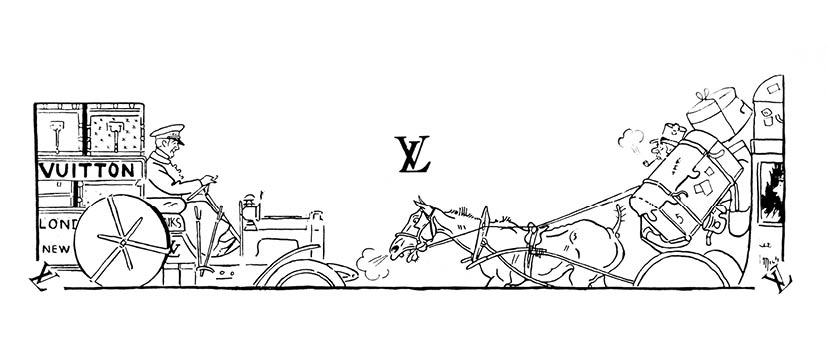
As one of the oldest fashion houses in history, Louis Vuitton is celebrating a landmark 200 years since the birth of its founder Louis Vuitton. The iconic brand will mark the anniversary with a series of moments that promise to evoke the life and legacy of this icon. Born in France in 1821, the visionary left his hometown of Anchay when he was just 13 years old. After arriving in Paris two years later after a journey on foot, Vuitton began his career at the age of just 16 by working as an apprentice for successful box-maker and packer Monsieur Romain Maréchal.
Vuitton’s passion and talent for what he did were evident from the beginning and when Napoleon assumed the title of Emperor of the French in 1852, his wife hired Louis Vuitton as her personal box-maker and packer. This provided a gateway for Vuitton to a class of elite and royal clientele who would seek his services for the duration of his life and far beyond.

Vuitton’s passion for creating trunks, bags and accessories developed when he founded his own Maison in 1854. With the idea of creating a concept that would combine the worlds of travel and fashion, he opened his company on 4 rue Neuve-des-Capucines, in the heart of the Place Vendôme neighbourhood.

“Three generations of Vuitton”: Portrait of Louis (1821–1892), his son, Georges (1857–1936) and his grandsons, Gaston-Louis (1883–1970) and the twins Jean (1889–1909) and Pierre Vuitton (1889–1917). Four photographs enhanced with quill and black ink, with white gouache highlights. ©ARCHIVES LOUIS VUITTON MALLETIER
His business began purely as a trunk maker but as times were changing and transport such as trains became a more convenient way to travel, he knew there would be a demand for the world of luggage trunks to develop and he set about reinventing the concept of fashion packing with his innovative designs.
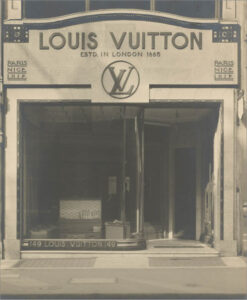
Légende : Façade du Magasin Louis Vuitton de Londres, 149 New Bond Street, 1924 : troisième magasin londonien après Oxford Street (1885) et Strand Street (1889). Etabli depuis 1982 aux 17-18 New Bond Street, la Maison est toujours présente sur cette artère du luxe. Louis Vuitton London Store, 149 New Bond Street, 1924. Photograph. Third London Store after Oxford Street (1885) and Strand Street (1889). © ARCHIVES LOUIS VUITTON MALLETIER
At the end of the 1850s, he created Gris Trianon, his most innovative trunk yet. Featuring a coated canvas that made luggage waterproof his technologically advanced invention radically transformed the shape of trunks which became rectangular allowing them to be stacked on top of one another and therefore much more practical than the previous dome shape. The Gris Trianon trunks were an immediate success and required Vuitton to expand his business in 1859 by opening an atelier in Asnières to accommodate the demand. The workshop opened with just 20 employees.
The original atelier has been expanded throughout the decades — including the addition of the Vuitton family residence — but it is still where products are crafted today. While the family home has been preserved and is part of a private museum, 170 craftsmen work in the Asnières workshop, designing and creating leather goods and special orders for clients around the world.
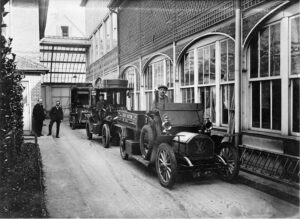
Légende : Chauffeurs et voitures de livraison Louis Vuitton dans la cour des ateliers d’Asnières-sur-Seine, vers 1903. Louis Vuitton Archives Louis Vuitton delivery vehicles and chauffeurs in the courtyard of the Asnières-sur-Seine workshops, circa 1903. Louis Vuitton Archives © ARCHIVES LOUIS VUITTON MALLETIER
Vuitton registered the patent of each technological or typological innovation he designed to ensure exclusivity for the Maison. In the 1890s canvas was used alongside leather and even aluminium, something that had never been seen in the trunk industry before. In 1885 Vuitton opened a store in London, the first outside of France. At the end of the 19th century, the House created the first supple bags, catapulting the brand into the world of high fashion.
By this point, the Maison had already achieved global success. Vuitton’s death in 1892 was a devastating moment for the House, but the forward-thinking businessman had already passed down precious savoir-faire techniques to the future generations including his son Georges, who created the company’s iconic LV monogram. Generation after generation the House has continued the spirit of innovation ever since, with the same core values and inspiration of travel at the centre of the house.
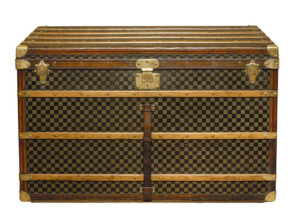
Malle Haute 110 (or high trunk) in Damier canvas, 1889, front view. Created in 1888, the Damier canvas bears the House’s signature. For the first time, the words “Marque L. Vuitton déposée” (L. Vuitton registered brand) appear, inscribed diagonally on a square of the Damier canvas. It was reproduced in 1996 and its checkerboard design has become one of the “symbols” of Louis Vuitton. © COLLECTION LOUIS VUITTON
This year, to mark 200 years since the birth of this icon on 4th August 1821, Louis Vuitton will present a series of creative initiatives. “Louis 200” will evoke the life and legacy of the founder featuring activations and collaborators from around the world. This will include a video game, as well as store windows that will showcase the iconic trunk as a vessel, reimagined by 200 contributors. A large-scale triptych of Louis will be pained by artist Alex Katz, and a novel about the life and intentions of Louis Vuitton will be published in October.
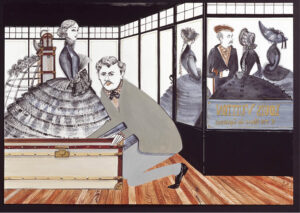
Légende : Maison Louis Vuitton was created in the time of crinolines. Young Louis Vuitton was a box maker and packaged the beautiful dresses of elegant ladies. Thanks to his unique savoir-faire, he becomes the Empress Eugénie’s favourite box maker. This prompted him to create his own brand in 1854. Next to the first Louis Vuitton store at 4 Rue Neuve-des-Capucines, Charles Frederick Worth opened his first store at 7 Rue de la Paix. Worth invented haute couture and was the first to sign his own designs. He also invented the “fit model”. Louis Vuitton and Charles Frederick Worth were close friends. Drawing by Ruben Toledo ©LOUIS VUITTON RUBEN TOLEDO POUR LES DESSINS ET LES TEXTES CALLIGRAPHIES
This will be complemented by a documentary; “Looking for Louis” that will be broadcast on Apple TV from December. The documentary will shed light on the man behind the Maison from his humble beginnings to his most successful moments. This tribute to a man whose great impact on the worlds of luxury, fashion and travel will transcend a typical tribute, it will create a bridge between the man himself and all the visionaries today who strive towards the horizon of their own life’s work. A man whose name is synonymous with unparalleled quality these activations will celebrate the life and legacy of this icon.















